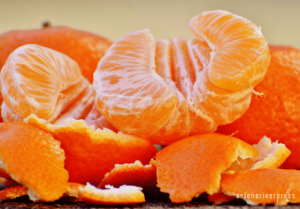Amazing; oranges taste the best and are the juiciest in winter. Here’s another great article by Paula Widish of Selene River Press that explains the benefits of eating citrus fruit during winter.
———-
 These days it isn’t so unusual to find discarded peels of fruit covering the bottom of our kitchen sink. The various shades of orange complement the black surface very nicely, I must say. While it’s an ongoing battle to get our boys to automatically clean up after themselves rather than leave their mess behind, it’s nice to see they’ve chosen a decent snack to satisfy those hunger pangs. After all, this is the season for delicious, juicy citrus of all kinds—and the perfect time to indulge.
These days it isn’t so unusual to find discarded peels of fruit covering the bottom of our kitchen sink. The various shades of orange complement the black surface very nicely, I must say. While it’s an ongoing battle to get our boys to automatically clean up after themselves rather than leave their mess behind, it’s nice to see they’ve chosen a decent snack to satisfy those hunger pangs. After all, this is the season for delicious, juicy citrus of all kinds—and the perfect time to indulge.
Isn’t it clever of Mother Nature to make sure the fruit of the winter season is jam-packed with vitamin C, a key nutrient for a robust immune system? While vitamin C is synonymous with citrus, it happily provides your body with other nourishment as well. Let’s look specifically at the easy-to-locate orange.
Flesh – Yes, the juiciest part of this fruit provides a one-two punch of vitamin C. It also gives you potassium, folate, and phytochemicals. These nutrients help with things like collagen formation, new cell formation, transmitting nerve impulses to your muscles, and keeping chronic disease at arm’s length. Delicious and nutritious.
Rind – Also known as the “outer skin” or “peel,” the rind houses the lovely flesh. If nothing else, it smells amazing—no matter which type of citrus you prefer. You can use the peel to freshen up your garbage disposal or, if you’re so inclined, add it to some homemade stovetop potpourri. It’s often used in dried potpourri too. Have you ever used citrus rind for making zest? The result of finely grating or scraping the outer skin, zest is commonly used in cooking and baking. The zest contains bioflavonoids (find out more in the Atwood article mentioned below), so be sure not to throw it away willy-nilly. Citrus zest adds a little something to most anything you make.
Pith – This is the papery white inner skin you find under the rind or outer skin. It contains all kinds of fiber and, as Maria Atwood points out in “Help! My Body Is Getting Flabby,” the pith contains P complex, or bioflavonoids. It’s a bit bitter, but I encourage our boys not to be too diligent about getting every last bit of the pith off before tossing a section into their mouths.
If you’ve ever been baffled by the wide array of citrus at the market, this article explains the characteristics of 12 citrus varieties, including when each is in season. A useful tool to find what you’re craving the first time around.
If you’d like to take your citrus game to the next level, give Chef Briana Nervig’s recipe for Seared Scallops with Grapefruit-Avocado Salad a try. You almost won’t want to eat it because it’s so pretty to look at. (I suggest you devour it though.)
And if you want a better understanding of vitamin C, you need to read Dr. Lowell Keppel’s “The Truth About Vitamin C.” A simple explanation of this complex nutrient and why ascorbic acid doesn’t quite cut it for your health.
Yes, the juiciest time of the year has arrived. Now get out there and take advantage of it!
———————–
Click this link to schedule your nutritional exam today to see what nutritional deficiencies your body has or call 303-886-0673.
**This blog is intended for educational purposes only and should not be used as a guide for diagnosis or treatment of any kind. This content is brought to you by the brilliant work and thinking of the pioneers of nutrition: Dr. Royal Lee, Dr. Weston A. Price, Dr. Melvin E. Page, Dr. Francis Pottenger, and many more for their ceaseless dedication to better nutrition and health!
Leave a Reply